
Modern homes are increasingly integrating smart technology to improve convenience, security, and energy efficiency. Among these advancements, LED sensor lights have emerged as a popular choice for homeowners looking to upgrade their lighting systems. These lights combine the benefits of LED technology with motion or occupancy sensors, offering practical advantages that align perfectly with contemporary lifestyles.
LED sensor lights are lighting fixtures equipped with LED bulbs and integrated sensors that detect motion or changes in ambient light. When motion is detected or lighting conditions change, these lights automatically turn on or off, making them highly efficient and user-friendly.
The sensor technology in LED sensor lights typically includes passive infrared (PIR) sensors, ultrasonic sensors, or microwave sensors. These sensors sense body heat, sound waves, or movement within a specific range and trigger the LED lights to activate. Once motion ceases or ambient lighting improves, the lights automatically switch off after a preset delay.
One of the primary reasons LED sensor lights are ideal for modern homes is their energy-saving potential. By automatically turning off when rooms are unoccupied, these lights prevent unnecessary electricity consumption. Combined with the inherent efficiency of LED bulbs, homeowners can enjoy significantly reduced utility bills.
LED sensor lights provide a hands-free lighting experience, turning on automatically when you enter a room or an outdoor space. This feature enhances convenience, especially in dark areas such as hallways, garages, or staircases. Additionally, the presence of sensor lights improves home security by illuminating areas when movement is detected, deterring potential intruders.
Indoors, LED sensor lights can be installed in various locations including bathrooms, closets, kitchens, and basements. Their ability to turn on and off automatically makes them perfect for spaces where frequent manual switching is inconvenient or where lighting is needed only intermittently.
Outside the home, LED sensor lights are valuable for illuminating driveways, patios, porches, and garden paths. They improve visibility and safety while minimizing energy use. Many models are weather-resistant, designed to withstand outdoor conditions and continue operating reliably.
When selecting LED sensor lights, consider the type of sensor and its sensitivity range. For instance, PIR sensors work well for detecting body heat in relatively close proximity, while microwave sensors cover larger areas and can detect movement through walls. Adjusting sensitivity ensures the lights activate appropriately without false triggers.
LED sensor lights come in a variety of styles, sizes, and finishes to complement home decor. Whether you want discreet ceiling-mounted fixtures or decorative wall sconces, there are options that combine aesthetic appeal with smart functionality. Integration with home automation systems can further enhance their utility.
LED bulbs are known for their long lifespan and resistance to frequent switching, which suits sensor-based operation perfectly. Unlike traditional bulbs, LEDs rarely burn out suddenly, reducing replacement frequency and maintenance costs.
Maintaining sensor performance involves periodic calibration and cleaning. Dust or dirt can impair sensor accuracy, causing delayed or missed activations. Regular checks help keep the LED sensor lights functioning at their best.

Using LED sensor lights supports eco-friendly living by cutting down on unnecessary energy consumption. Reduced power usage means fewer greenhouse gas emissions from electricity production, contributing to environmental conservation efforts.
Though initial costs for LED sensor lights may be higher than traditional fixtures, the long-term savings on energy bills and reduced maintenance make them a cost-effective investment for homeowners. These benefits align well with modern priorities for sustainable and economical home upgrades.
Yes, many LED sensor lights are compatible with popular home automation platforms, allowing seamless integration and enhanced control.
Adjusting the sensor sensitivity and positioning the lights away from moving objects such as trees or pets can reduce false activations.
Many LED sensor lights are designed with weather-resistant features, making them suitable for outdoor use in various climates.
LED sensor lights typically last between 25,000 to 50,000 hours, depending on usage and environmental conditions.
LED sensor lights can reduce energy consumption by up to 80% compared to incandescent bulbs, especially when combined with motion sensor technology.
 Hot News
Hot News2024-06-06
2024-06-06
2024-06-06